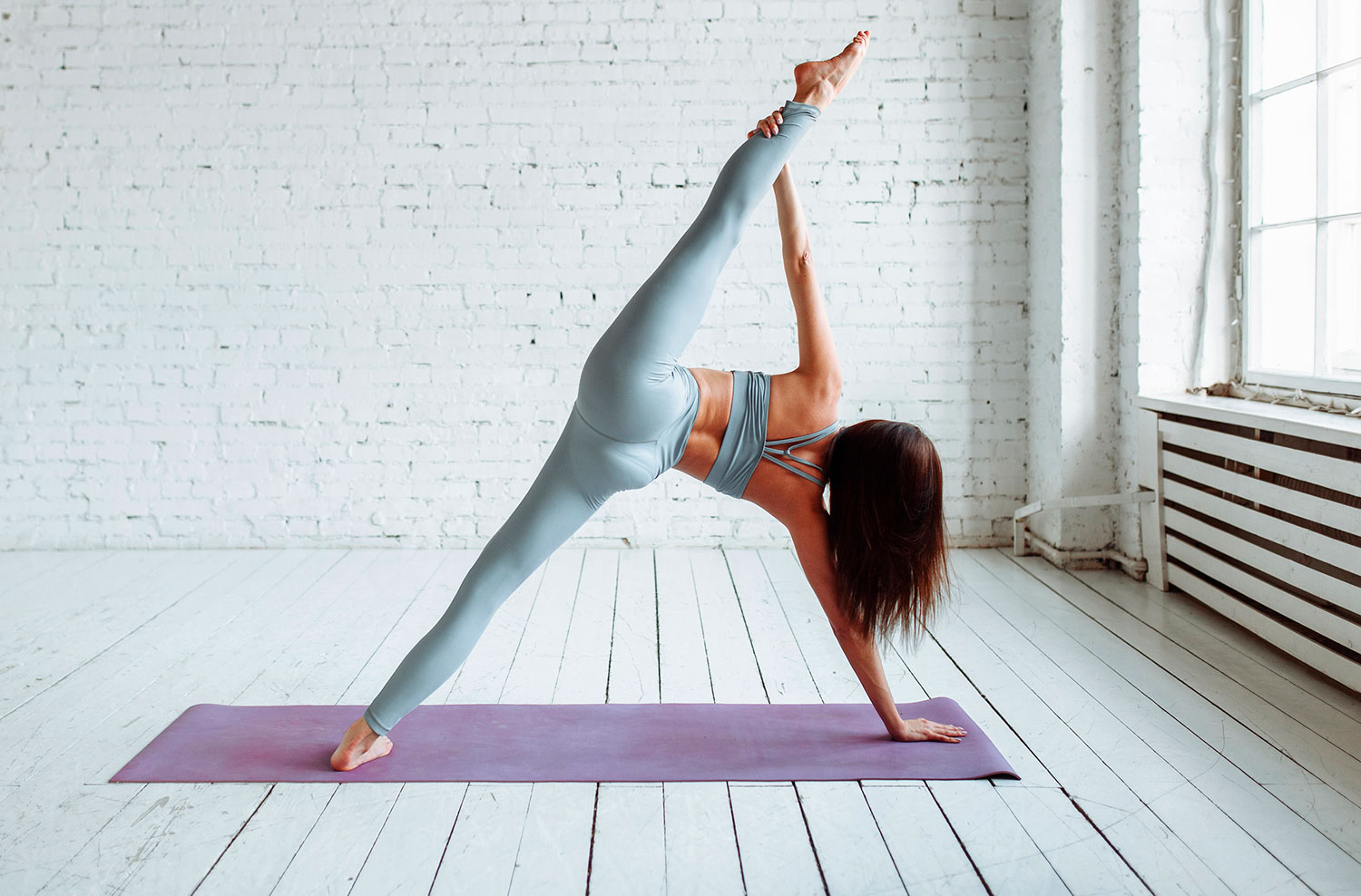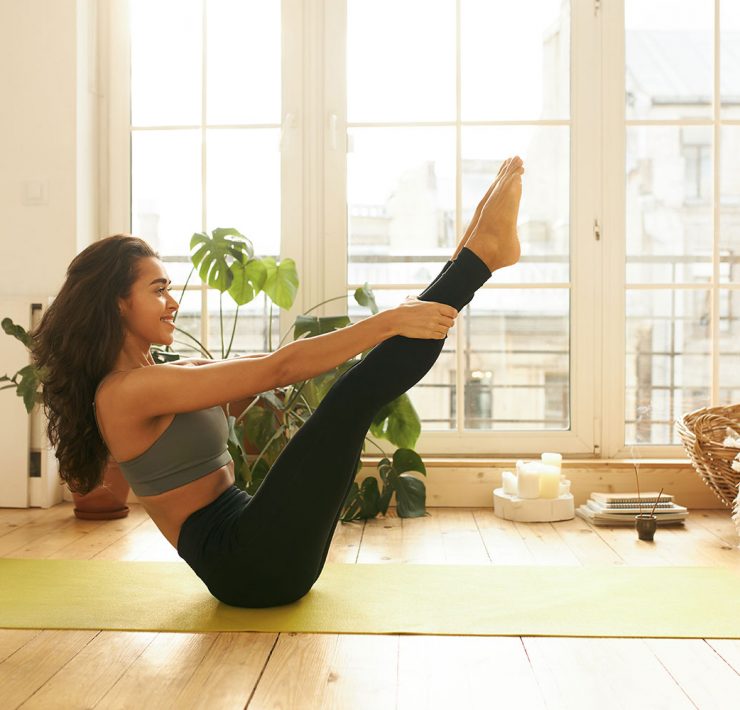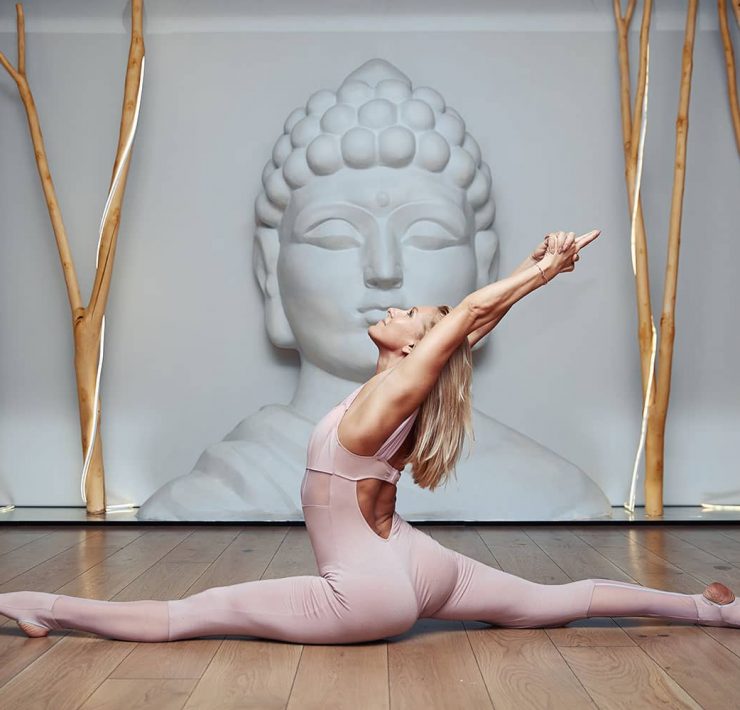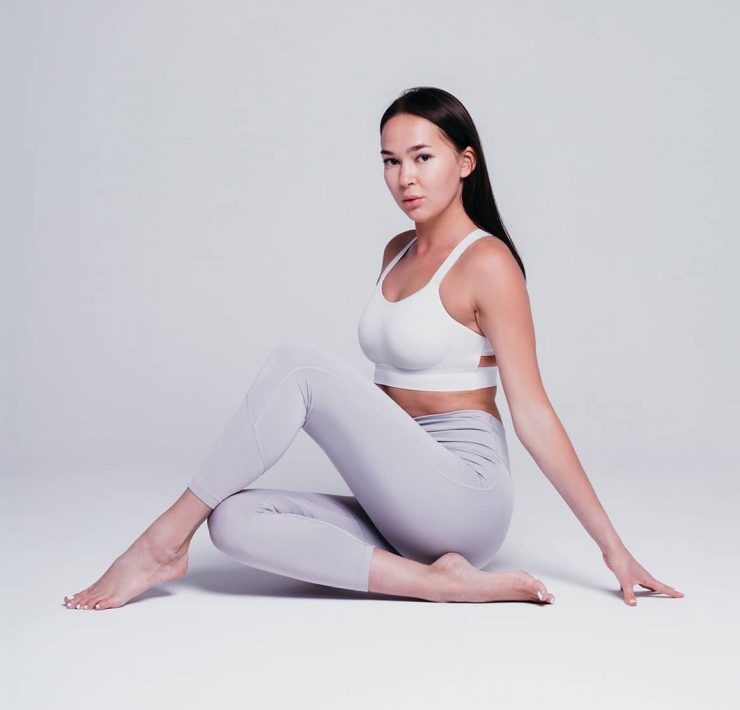
Rose graduated with a degree in Anthropology, which takes her…
Many people come to yoga for the same reason they are frightened of it: flexibility. Lack of flexibility can cause many issues such as aches, pains, limited range of movement, and even hamper daily tasks like sitting down or picking things up. However, when people new to yoga think of the practice, they often picture advanced asanas. There is a reason that many non-yogis refer to lotus pose as ‘pretzel pose.’ The flexibility required for advanced asanas can be extremely intimidating. Nevertheless, yoga is actually a very accessible way to increase flexibility. There are hundreds of poses that can be adapted for a person’s level of flexibility (or lack thereof). There is nothing to be frightened of with a little background knowledge and guidance on the best yoga poses for flexibility.
Why Tight Hamstrings Are A Problem

One of the most common complaints when it comes to lack of flexibility is tight hamstrings. Many people have tight hamstrings, either from genetic predisposition or lifestyle factors. There are many aspects of Western culture that can contribute to tight hamstrings, in particular sitting all day in cars, at desks, and at tables. Exercise regimes such as, in particular, running, can also tighten hamstrings even further.
Tight hamstrings can be a big problem when it comes to total body health and quality of life. Tight hamstrings make it painful to bend forward, a movement that is necessary when picking things up off the floor, putting on shoes or socks, and so much more. It can make it painful to sit cross legged and even climb stairs. Furthermore, tight hamstrings cause imbalances in other muscle grounds. Commonly, tight hamstrings will lead to back pain and sciatica. It is important to address tight hamstrings, and an easy way to do that is through yoga.
Anatomy of The Hamstring

Before addressing tight hamstrings with yoga, it is important to have an underlying knowledge of the anatomy of the hamstring. The term ‘hamstring’ is actually misleading. Located at the back of the upper leg (or in anatomical language, the posterior thigh), the hamstring is not one big muscle. In fact, it is formed of three separate muscles. These are the semitendinosus, semimembranosus, and biceps femoris.
In anatomical language, every muscle has an ‘origin’ and ‘insertion.’ This refers to where the muscle is attached to bone, and can explain how the muscle moves the bone, and therefore the body, when it contracts. All three of the hamstring muscles have the ischial tuberosity as their origin. The ischial tuberosity is more commonly referred to as the ‘sits bones.’
The muscles then travel down the back of the thigh until they reach their various insertions, where they end. The semitendinosus inserts at the Pes Anserine of the tibia bone. The semimembranosus inserts at the medial tibial condyle. Finally, the biceps femoris (the largest of the three muscles), inserts at the outside head of the fibula.
All together, the three hamstrings are the muscles that enable you to flex your knees and extend your leg behind you. They are integral to every day movements such as walking, climbing, bending, and more.
Poses for Hamstring Flexibility
The following poses will help you increase your hamstring flexibility. They are listed in order of increasing level of required flexibility, with the most challenging poses listed last. Attempt the poses in stages, and try to hold each one for a minimum of 30 seconds.
Stretching too far, and not warming up before stretching, can injure and further tighten hamstrings. Listen to your body, practice mindfulness, and breathe through each pose.
Uttanasana – Standing Forward Bend

One of the seemingly simplest yoga poses is also the best for hamstring flexibility. Uttanasana, or Standing Forward Bend, is a staple in both Sun Salutation A and B. To get its full effect, hold it for an extended period of time.
How to practice Uttanasana: To practice Uttanasana, stand at the front of your mat, feet together. Inhale to a half flat back, and exhale release so you are folding forward. Let your arms and hands hang heavy. Be conscious of your neck and head in this pose – don’t put any tension or lift in your neck. Try nodding your head ‘yes’ and ‘no’ to release the head and let it hang toward the mat like a weight at the end of your spine. Try to keep as straight a back as you can rather than hunching over. If you feel painful stretching in your hamstrings, bend your knees slightly to alleviate the pain.
Adho Mukha Svanasana – Downward Dog

Another staple in most yoga sequences is Adho Mukha Svanasana, also known as Downward Dog. It is a ‘beginner’ yoga pose that often scares away people with tight hamstrings because it can be very challenging and requires both strength and flexibility. Approach it with a forgiving mind and remember you can always adapt and take breaks.
How to practice Adho Mukha Svanasana: From plank, press back into Downward Facing Dog. Your hands should be shoulder width apart, and your feet hip width apart. Press evenly through all fours and try not to dump your weight into your shoulders or arms. For hamstring flexibility, remember to reach your sits bones to the back of the room. Let your heels sink toward the mat, although they may not touch. You can also bend, or ‘bicycle,’ your legs in this pose as you are warming up. Lean into one leg at a time as you work on your flexibility.
Paschimottanasana – Seated Forward Fold

Paschimottanasana, or Seated Forward Fold, is often practiced in Yin Yoga classes or as the finishing poses for most classes. It is a contemplative and restorative pose that is wonderful to do at the end of practice, once the body is completely warmed up. Practice with humility and do not push yourself too far.
How to practice Paschimottanasana: Sit at the back of your mat with your legs together and extended out in front, your feet flexed so your toes are pointing toward the ceiling. Inhale your arms straight up and overhead, and exhale extend your arms down your legs. This pose is tricky for hamstring flexibility, as many people with tight hamstrings will hunch their back over so their fingers can reach their toes. You must let go of your ego in this pose and keep your back completely straight and heart open. Although your hands may only come down to your thighs or knees, you will feel more of a stretch in your hamstrings.
Trikonasana – Triangle Pose

Trikonasana, or Triangle Pose, is a wonderful pose for hamstring flexibility. Unlike the previous three poses, it must be practiced on each side of the body as it only stretches the front leg’s hamstrings. It is a good pose to incorporate into a vinyasa yoga sequence.
How to practice Trikonasana: Stand with your feet about a leg’s distance apart. Your back foot should be parallel to the back of your mat. Your front foot should point forward, with the heel aligned with the arch of the back foot. Extend your arms out to shoulder height. As you inhale, reach the front arm forward, simultaneously lifting and reaching your back hip back. Exhale and tilt forward, staying on a flat plane. Reach your front arm so your fingers find a clasp on your front leg (or toes, if your hamstrings are flexible enough). Reach your back arm up toward to ceiling and follow this with your gaze. As you work on your hamstring flexibility, you want to keep your front leg straight. To adapt Trikonasana if you need a less intense stretch, just walk the front arm further up your leg.
Supta Padangusthasana – Reclined Big Toe Pose

This is another pose that is ideal for Yin Yoga sessions or the finishing poses of a vinyasa practice. You can hold it for an extended period of time, breathing into your hamstrings with ujjayi (or ‘victorious’) breath. There are many adaptations for Supta Padangusthasana depending on your flexibility level. It is best to practice this with a strap nearby if you have tight hamstrings. You will have to repeat the pose at least once on each side.
How to practice Supta Padangusthasana: Lie flat on your back on your mat with both legs extended. Gently, bend one knee and bring that leg into your chest. For a modified version, clasp your hands behind your thigh and extend the leg straight up with the foot flexed. If you have very tight hamstrings, you may have to keep your knee bent. As you advance your flexibility, use a strap. Place the strap around the sole of your foot, holding on to either end, and extend the leg toward the ceiling. One day when your hamstrings are flexible enough, you will be able to find a clasp with your fingers around the big toe as your leg is extended. In each variation, keep your back flat on the mat and breathe consciously into the stretch.
Prasarita Padotanasana – Standing Wide Legged Forward Bend

Prasarita Padotanasana is a wonderful pose to work on hamstring flexibility in both legs at once. Because it is also an inversion, it can help detoxify, reduce headaches, relieve anxiety, and lower blood pressure, among other benefits. Try it with various arm variations.
How to practice Prasarita Padotanasana: Stand with your legs about double hip width apart. Feet should be parallel to the short end of the mat, facing toward the side of the room. Keep your thighs engaged and your kneecaps lifted. Clasp your hands behind your back, rolling your shoulders back, and inhale and lift your gaze toward the ceiling. Exhale and fold forward, keeping your lower body stable and feeling your pelvis rotate around your femur. Let your upper body hang down loosely, and breathe into the stretch in your hamstrings.
Parsvottonasana – Pyramid Pose

Parsvottonasana, also known as Pyramid Pose or Intense Side Stretch Pose, may look like it is a simple pose, but it actually can be very challenging for those with tight hamstrings. It is one of the best poses to increase hamstring flexibility, when done correctly. Make sure you repeat it on both sides for the full benefit.
How to practice Parsvottanasana: From Warrior II stance, step your back foot about a foot closer, so your stance is shortened. Point your back foot toward the front of the mat so your hips are squared, and straighten your front leg. Place your hands in reverse Namaste, or if your shoulders are tight you can clasp opposite elbows behind you. Inhale and look up, and exhale and lean forward over your front leg. As you deepen into the pose make sure you are hinging from the hips and maintain a straight back. Keep your front hip back, and you will feel an intense stretch in your front leg’s hamstrings.
Uthita Hasta Padangustasana – Extended Hand to Big Toe Pose

Uthita Hasta Padangustasana is very similar to the previously mentioned Supta Padanghustasana, except you perform it standing. The addition of balance makes this a slightl more challenging pose. Remember that there are many variations, and you can always use a strap to assist you in finding a bind.
How to practice Uthita Hasta Padangustasana: Stand at the top of your mat in Tadasana, or mountain pose. From here extend one of your legs out in front, balancing on the other leg. The full expression on the posture involves finding a bind with your fingers around the extended leg’s big toe. However, for tight hamstrings, you can practice adaptations using a strap, or clasping behind the thigh, or even bending the knee.
Hanumasana – Monkey Pose

Hanumasana, also called Monkey Pose, may actually be most well known as the splits, and its full expression can be very intimidating for those with tight hamstrings. However, practicing adaptations of Hanumasana can lengthen the hamstrings gradually, if it is practiced safely. Flexibility in the hip flexors is also necessary to practice the full expression of Hanumasana.
How to practice Hanumasana: From a kneeling position, extend one leg forward, keeping the knee straight. For many with tight hamstrings, holding this position may be enough to start with. As your flexibility advances, you can transfer your weight onto your palms (or place your hands on blocks). From there, you can extend your back leg gradually backward, straightening the knee. Make sure to keep your hips squared toward the front of the mat to ensure safety and proper stretching of the hamstrings.
Tittibhasana – Firefly Pose

Tittibhasana is the most advanced of the ten poses mentioned here. It requires arm and core strength, and lifting of the bandhas, in addition to flexible hamstrings. It is a central pose of the Ashtanga yoga practice so may be familiar to those who practice the primary series. It should be attempted after the body is warmed up.
How to practice Tittibhasana: Plant your hands a few inches apart and flat on the mat. Plant your feet on either side of your hands, and a few inches forward of them. Bend your knees until the backs of your thighs are resting on your upper arms. From here, slowly heel-toe your feet together and in front of your arms. If you have the core and upper arm strength, wrap your ankles around each other and lift your feet off the mat. Once you are balanced, unwrap your ankles and extend your legs out. This is where you will feel the hamstring stretch. To maintain the lift, press your palms into the mat and breathe deeply.
Conclusion
These ten poses will set you on a path to releasing tight hamstrings and gaining flexibility. Remember to listen to your body and warm up thoroughly before each pose. There are many adaptations for each pose, and props can be used such as straps, blocks, and blankets. It Is essential not to stretch too far too fast, or you may end up straining your hamstrings and making them even tighter.
Ultimately, remember that yoga extends beyond the mat. You are more than your body and muscles. Asanas, or yoga poses, were originally made so as to enable more ease in sitting for meditation. With increased flexibility, you may find it is easier to engage in other yogic practices off the mat.

What's Your Reaction?
Rose graduated with a degree in Anthropology, which takes her understanding of basic human needs to a whole new level. Her intelligence and passion for healthy living is reflected in her written work.















This is really helpful, thanks.
I do consider all the concepts you’ve offered in your post. They’re really convincing and will certainly work. Nonetheless, the posts are very brief for novices. May just you please lengthen them a bit from subsequent time? Thank you for the post.